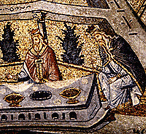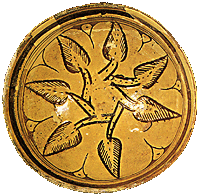 |
|
 |
Elements of everyday life
 s written sources suggest, everyday life for the average Late Byzantine
s written sources suggest, everyday life for the average Late Byzantine
 citizen was devoid of all luxury. This of course reflects the wretched economic situation of the population of Byzantium at the time. The people endeavoured to supply their basic needs as cheaply as possible. citizen was devoid of all luxury. This of course reflects the wretched economic situation of the population of Byzantium at the time. The people endeavoured to supply their basic needs as cheaply as possible.
One might wonder whether the simple everyday items of a household in the 20th century, such as beds, chairs and dishes, were part of a late-Byzantine household. In an attempt to approach this question, professor N. Oikonomides undertook a comparative study of late-Byzantine documents and came up with some extremely interesting conclusions. He found that, during that period, there were two kinds of
 households, the existence of which was already known from previous periods. There were households that possessed tables, chairs and beds, and which must have been the more prosperous ones, while there were others in which stone or wooden benches along the walls were used both as seats and beds. Their food was placed beside them or on the chests they used to store foodstuffs and other household goods. It would appear that the family all ate out of a common dish and drank from a common cup or jug. households, the existence of which was already known from previous periods. There were households that possessed tables, chairs and beds, and which must have been the more prosperous ones, while there were others in which stone or wooden benches along the walls were used both as seats and beds. Their food was placed beside them or on the chests they used to store foodstuffs and other household goods. It would appear that the family all ate out of a common dish and drank from a common cup or jug.
Similarly, conclusions may be drawn concerning the
use of all or at least of most of the objects in a household. What is
important as regards the late Byzantine period is that the second type of
household, that is the poorer one, was the most prevalent one, a fact
which is indicative of the social and economic standard of living of that
period.
|